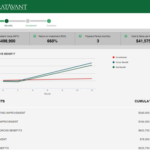It’s happened to the best of us. You tell a prospect how much your product or service costs and they respond with silence. This is known as “sticker shock” and if you’ve done your job as a salesperson, your customer should never experience this.
It’s essential to establish solution value and discuss price early on to eliminate any price sensitivity. However there will be times when, despite your transparency, the prospect may not have paid attention or begun thinking about pricing.
Here are four ways to avoid sticker shock in your sales process to help you get it right from the start.
1. Set Expectations
Sticker shock occurs when there’s a disconnect between expectation and reality. You have to set your prospects’ expectations early on in the sales process so that even the slightest disappointment doesn’t send them running. The lack of managing expectations is responsible for killing many sales transactions. In order to build trust and credibility, you must set the correct expectations and always deliver on your promises, no matter how small.
2. Be Confident About Your Price
If you provide value to your customers, then your price is well justified. If you feel uncomfortable talking about price, dig deep and find out why. Prospects will pick up on your discomfort and react accordingly. Conversely, if you are open and feel confident about your price, your prospects and customers will naturally feel comfortable with it.
3. Don’t Speak in Abstracts
When discussing price, use actual numbers and concrete words. Don’t use words like “cheap,” “inexpensive,” “reasonable,” etc. These abstract terms mean different things to different buyers and contain no frame of reference. Instead, speak in absolute terms.
If your product has different components or pricing depends on a customer’s backend infrastructure, for example, simply say that you’re not equipped to have a budget discussion right now because you don’t have enough information. Don’t set your prospect up for sticker shock by saying something like “Let’s not worry about pricing now; I’m sure it’ll be a non-issue.” Tell them, “We really need to understand your backend infrastructure before we can provide pricing.”
4. Make Them Think It’s More
If you can’t really gauge what the price will be, you can’t discuss cost concretely or even comparably. Prepare them instead for a price that’s higher than what you think the actual amount will be. If you’ve successfully demonstrated the value of your offering and know the prospect has adequate funds to invest, coming in under their anticipated budget will allow you to accelerate the close without discounting.
Conclusion
Don’t make price a bigger deal than it is. Instead, deal with it early on in the sales process and demonstrate tremendous value. Many people would rather pay more for exceptional service and value. As long as you provide that and set proper expectations, you’ll be quicker to close and won’t have to try as hard to make the prospect happy with the purchase decision—they’ll already be 100% sold.
This post was updated on January 14, 2025 to reflect the latest industry trends.

Resources
Connect with Darrin Fleming on LinkedIn.
Join the Value Selling for B2B Marketing and Sales Leaders LinkedIn Group.
Visit the ROI Selling Resource Center.













